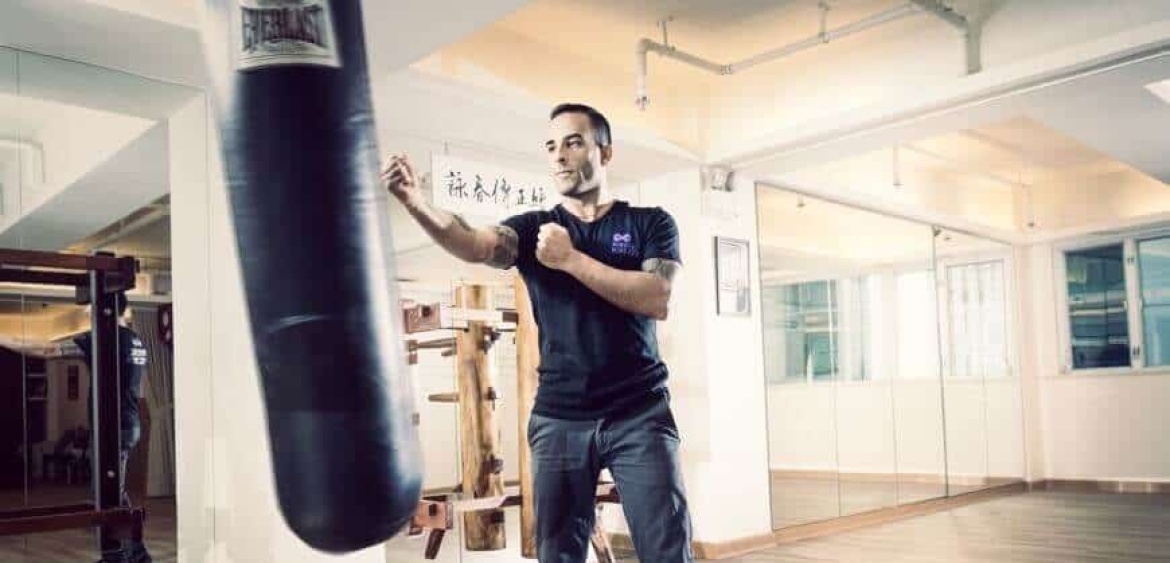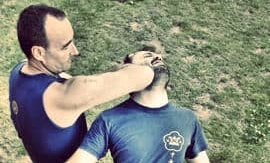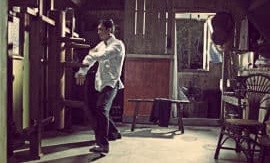
SIFU NIMA KING WAS FORCED INTO MARTIAL ARTS, DUE TO A VERY INTENSE FIGHTING PERIOD, DURING HIS TEENAGE YEARS; BY PURE LUCK, HE DISCOVERED AND BEGAN TRAINING WING CHUN, UNAWARE IT WAS A MINDFUL CHOICE, ONE THAT WOULD CHANGE HIS LIFE.
What do you believe to be the core attribute of Wing Chun?
The most important attribute is mindfulness; that is the ability to activate the Nim Tau (“Mind Force”) state and a deep level of relaxation through the correct and prolonged practice of Siu Nim Tau. This state is the pinnacle of this remarkable art and is an aspect that can change one’s quality of life tremendously. From a martial point of view, Wing Chun’s harmony with the laws of physics enables supreme efficiency, practicality and power to be unleashed.
How important is Chi Sau?
Most practitioners know that Chi Sau is the main cooperative exercise aimed at developing sensitivity, not to be merely developed at the contact point (within the arms), but rather within the entire body. This level of sensitivity requires relaxation and expansion of every joint and mindfulness throughout the whole body, keeping it internally connected under incoming force. In this way, we can effectively use our centre of mass, rather than muscular structure, as our main source of power, allowing every movement to be effortless yet tremendously powerful. The main emphasis should be working towards the ability to maintain the body (and mind) in a state, which can’t easily be disturbed by the opponent and, therefore, gain access to our centre. This, I believe, is the highest level of practice, and at this level, we can gain full control of our opponent’s centre of balance.
Do you believe the empty-hand forms play an important role?
I believe the forms, Siu Nim Tau, in particular, are the most important tools; they teach us the mental and physical foundations of Wing Chun. In Siu Nim Tau, we learn to relax our muscles and joints to a very deep level. This, coupled with the understanding of the circular and triangular structural intentions within each move, enables us to receive and give great amounts of power with very little brute force.
Chum Kiu teaches how to find our centre of mass and utilise it as the main source of power behind each move. Biu Jee lets us practise the ability to move from our centre at full speed while maintaining the mindful and relaxed Siu Nim Tau state. If performed correctly, the force generated is the most powerful of the three empty-hand forms. The Wooden Dummy is a tool to apply the tools, gained from the first three empty-hand forms. The main emphasis while practising the Wooden Dummy form should be that, with every move, our mass is affecting the mass of the dummy, rather than just smashing the arms around.
Finally, the weapons training enables us to practise transferring our mass through the external object (Knives or Long Pole), almost as if they are merely an extension of our arms. It’s extremely difficult to perform the weapon forms correctly because it requires one to be able to relax and “expand” the joints of the wrists and fingers. In my opinion, a student who doesn’t spend the majority of their training time studying each form intently will not be able to achieve a substantial level of skill and understanding of the art.
What’s your opinion on the differences between the Chinese versions of Wing Chun and worldwide?
I have had a lot of play with various lineages and masters in Hong Kong, Australia and Europe, and have experienced many versions of Wing Chun. With all due respect to the practitioners out there, many times, I find people have misinterpreted and missed some points in understanding the internally fundamental roots of Wing Chun and, as a result, have confined themselves to the exterior principles and structures of Wing Chun. Without the internal aspect, Wing Chun is not a perfect martial art, which is why someone, like Bruce Lee, felt he needed to add/subtract some things. On the contrary, once the prime focus is on the development of deep relaxation and Nim Lik (force generated from a highly focused mind), Wing Chun remains truly perfect.
What would you consider to be the core essentials of Wing Chun?
Mindfulness: cultivating a deep level of mental and physical awareness.
Relaxation: many people mistake this for the same relaxation of the muscles when slouching while sitting on a couch (mindless relaxation), but I’m actually talking about “mindful” relaxation, which enables the joints to decompress and expand and, ultimately, leads to release of energy within the entire body.
Balance: maintaining awareness of the relationship of our body with gravity throughout every posture and movement. Practising Siu Nim Tau on one leg is a very useful tool for finding pure balance.
Persistent and Patient Practice: I think, to get a true taste of the beauty and depth of this internal art, we must practise patiently every day and incorporate the above-mentioned aspects and the philosophy of Wing Chun into our daily lives.
What’s your view on whether structure is needed?
Understanding and working with correct geometrical structures and shapes is important to cultivate the internal side of Wing Chun because they enable the use of natural laws of physics to withstand and produce force. This allows using minimum brute force in all our moves, which keeps the mind and body in a calm and settled state, making them the perfect cultivation ground for releasing “Mind Force.” Once we get access to it, the favourable and advantageous structural positions become less important, because we can utilise our full body mass, regardless of our structure.
How important is footwork and how do you train it in your system?
Once you can truly gain access to our centre of mass as the main engine for our body movements, footwork becomes rather unimportant, because the feet, legs, and the rest of the body will move, connected to and as extensions of our centre of mass. Wing Chun is the only form of martial art in which we don’t need to use Jup Maa (force from the use of a stance i.e. using the legs to push off the ground to produce force).
If we think about moving our body and use our legs as the main engine, there’s always a leg we need to push off when we move, i.e. our mass will shift from one leg towards the other, and we push off the latter when moving forwards. During the weight shift, we will not be able to kick with the leg that is supporting our mass, and the force produced in this way doesn’t utilise the entire body weight and is more of a structural force, which requires a specific body alignment. However, if one can utilise their centre of mass correctly, it feels and looks like they have access to a third support, regardless of the position of the legs, and will be able to kick from either leg without having to shift their mass; the legs feel very light and the entire body could move in every direction. The force produced will be enormous as the entire body weight is being shifted around as one unit. Having said that, I still think it’s crucial, during practice, that we always try to point the feet slightly inwards when stepping and moving around. This is only so we can learn how to focus our entire mass forward into the centreline. Once this intention has been developed, even pointing the toes inwards will not be as important.
Do you believe that Wing Chun needs internal development to be effective?
There is a lot of talk about it, but since not many have attained a high enough level in terms of utilising “Mind Force”, many focus on teaching the mechanics and fighting principles. During my years working security in Australia, I had to use my Wing Chun many times to defend others and myself, and even though only applied as an external martial art, it was still very effective in real combat. However, I can also say that since I started training “internally”, my power, speed and fighting ability is at a much higher level than during my security years. I started practising Wing Chun to become a better fighter, but I can honestly say this passion has been greatly replaced with the one of exploring and sharing the life-changing internal side of this beautiful ancient Chinese art. This is the reason I have literally dedicated my life to Wing Chun.



















